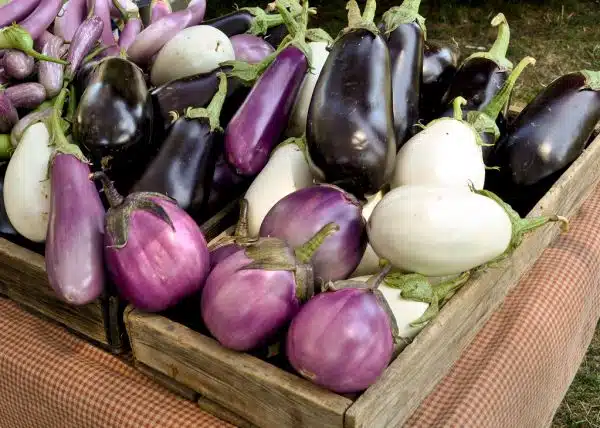Eggplants are a versatile vegetable that can be cooked in a variety of ways, from grilling to roasting, frying to sautéing. While most people are familiar with the traditional purple eggplant, there are actually many different types of eggplants available, each with their own unique taste and texture. In this article, we will explore eight unusual eggplant types and how they can be used in cooking.
From the striped Listada de Gandia to the miniature Fairy Tale eggplant, these lesser-known varieties offer a range of flavors and colors that can add excitement to any meal. Whether you’re looking for a new ingredient to spice up your favorite recipes or simply want to experiment with something different in the kitchen, discovering these unusual eggplant types is sure to broaden your culinary horizons. So let’s dive in and explore some of the most interesting and delicious eggplants out there!
Listada De Gandia Eggplant
Listada de Gandia Eggplant is a unique and visually appealing type of eggplant that is native to Spain. The eggplant has a distinctive appearance, with white and purple striped skin that looks like it has been painted on. This eggplant variety is also known for its mild flavor, making it an excellent choice for various culinary applications.
Growing tips for Listada de Gandia Eggplant involve planting the seeds in warm soil and providing consistent moisture throughout the growing season. These plants require full sun exposure to thrive and should be kept in well-draining soil. To encourage healthy growth, gardeners can also feed the plants with a balanced fertilizer.
Culinary uses for Listada de Gandia Eggplant are varied due to its unique flavor profile. This variety can be used in traditional Mediterranean dishes such as ratatouille or moussaka, but it can also be grilled or roasted to bring out its sweetness. Its vibrant color makes it an ideal addition to salads or as a garnish on top of other dishes. Overall, Listada de Gandia Eggplant is a versatile and tasty addition to any kitchen.
Moving onto the next unique type of eggplant, we have globe eggplants which are widely consumed across different cultures around the world.
Globe Eggplant
Globe eggplant is a versatile vegetable that can be used in a variety of cuisines. Its unique shape and flavor make it an exciting ingredient to experiment with in the kitchen. Due to its globe shape, it is also known as the “American” or “Italian” eggplant.
Growing and harvesting tips for globe eggplant are similar to those of other eggplant varieties. They require warm weather, full sun exposure, and well-draining soil. It’s essential to keep the soil moist but not waterlogged during the growing season. You can harvest globe eggplants when they reach their mature size, which is typically around 4-6 inches in diameter.
The versatility of globe eggplant makes it an excellent choice for cooking enthusiasts who want to explore new flavors and textures. Whether roasted, grilled, stir-fried, or baked, this vegetable can add depth and complexity to any dish. Some creative ways to use globe eggplant include:
- Sliced into rounds and baked until crispy for a healthier alternative to fries
- Grilled and used as a topping on pizzas or sandwiches
- Roasted with other vegetables for a colorful side dish
- Cut into cubes and added to stews or curries
As we move onto discussing rosa bianca eggplant in the next section, keep in mind that both varieties have unique characteristics that make them stand out from traditional purple eggplants. It’s worth exploring different types of eggplants to expand your culinary horizons and discover new flavors.
Rosa Bianca Eggplant
Moving on from the globe eggplant, we come to another fascinating variety – the rosa bianca eggplant. This Italian heirloom is known for its stunning appearance with its light purple and white striped skin. It has a unique flavor profile that is milder than other types of eggplants and a creamy texture when cooked.
When it comes to cooking techniques for rosa bianca eggplant, it can be prepared in various ways such as grilling, roasting, or frying. One popular dish is to slice it into rounds and grill them until they are tender while still retaining their shape. Another way is to roast them with some olive oil and seasoning until they turn golden brown. Additionally, you can also fry them to create crispy fritters or use them in stews and curries.
Aside from its delicious taste and versatility in cooking, rosa bianca eggplant also offers several health benefits. It contains high levels of antioxidants, specifically nasunin which helps protect cells from damage caused by free radicals. It also has fiber that aids digestion, potassium that regulates blood pressure, and vitamins C and K that support bone health.
The rosa bianca eggplant is an excellent addition to any meal due to its unique flavor profile and versatility in preparation methods. Its health benefits further add value to this variety of eggplant making it a great choice for those looking for nutritious yet flavorful ingredients in their dishes. Next up we have the Chinese eggplant which boasts a more elongated shape compared to the ones we’ve discussed so far.
Chinese Eggplant
A succulent and tender variety of eggplant, Chinese eggplant is a delicacy that has won the hearts of many food lovers. With its long and slender shape, this eggplant type is perfect for stir-fries and other Asian-inspired dishes. Chinese eggplants have a more delicate flavor than their larger counterparts, which makes them ideal for absorbing the flavors of the ingredients they are cooked with.
If you’re wondering how to cook Chinese eggplant stir fry, it’s best to start by slicing the eggplant into thin pieces. Afterward, sauté garlic in oil until fragrant and then add in the sliced eggplants. Allow the eggplants to cook until tender before adding in your choice of protein and vegetables. Season with soy sauce, oyster sauce, or any other seasoning of your choice for an authentic Asian taste.
Apart from its delicious taste and versatility in cooking, Chinese eggplant also offers several health benefits. It is low in calories but rich in fiber and nutrients such as potassium, iron, and vitamins B1 and B6. This makes it an ideal vegetable for those looking to lose weight or maintain a healthy diet.
Moving on to our next topic, Japanese Eggplant offers another unique twist on this beloved vegetable.
Japanese Eggplant
Moving on from Chinese eggplants, another unique type of eggplant worth exploring is the Japanese eggplant. With its slender and elongated shape, Japanese eggplants have a deep purple color and a tender texture that makes them ideal for cooking in various ways. To make the most out of this eggplant, here are some helpful tips on how to cook it.
One way to prepare Japanese eggplants is by grilling or roasting them. Simply cut them lengthwise into thin slices, brush them with olive oil or any preferred seasoning, then grill or roast until they turn soft and slightly charred. This method enhances their natural sweetness while giving them a smoky flavor that complements different dishes.
Aside from its versatility in cooking, Japanese eggplants also offer numerous health benefits. They are low in calories but high in fiber and essential nutrients such as potassium, vitamin C, and folate. Regular consumption of this eggplant can help lower blood pressure levels, improve digestion, boost immune system function, and reduce the risk of chronic diseases such as heart disease and cancer.
Transitioning to Indian eggplants, these small-sized variants have a dark purple color with white streaks on their skin. Despite being small in size, Indian eggplants pack a punch when it comes to flavor and nutrition. Stay tuned to discover more about these unique types of eggplant!
Indian Eggplant
Indian eggplant is a type of eggplant found in India, along with many other varieties. The most common varieties of Indian eggplant include the round and long varieties, with sizes varying from small to large. Indian eggplant can be grown in most climates and need to be watered regularly and fertilized to ensure healthy growth. When harvesting, it is important to allow the eggplant to reach full maturity and to collect them before the first frost.
Varieties Of Indian Eggplant
The varieties of Indian eggplant are as diverse as they are unique. From the round and plump purple eggplant to the slender and elongated green ones, each type boasts its own distinct flavor and texture. One popular variety is the white eggplant, which has a delicate flavor and tender flesh that pairs well with spices like cumin and turmeric. Another notable type is the striped or mottled eggplant, which has a slightly sweet taste that makes it ideal for curries.
When it comes to recipe ideas, Indian eggplants offer endless possibilities. One classic dish is baingan bharta, a smoky roasted eggplant dip that’s seasoned with spices like garam masala and coriander. For those looking to add more veggies to their diet, stuffed eggplants make for a filling and healthy meal. Simply slice them in half, scoop out the flesh, mix it with spices and vegetables like onions and tomatoes, then bake until tender.
In addition to their culinary versatility, Indian eggplants also boast an array of health benefits. They’re low in calories but high in fiber, making them a great addition to any weight loss plan. They’re also packed with antioxidants like nasunin, which has been shown to protect against cellular damage and reduce inflammation in the body. With so many delicious varieties and health benefits to choose from, it’s no wonder Indian eggplants have become a staple ingredient in kitchens around the world.
Growing Indian Eggplant
Growing Indian eggplant is a rewarding experience for any home gardener. This vegetable thrives in warm climates and requires full sun exposure to grow properly. Tips for growing Indian eggplant include starting the seeds indoors six to eight weeks before the last frost, using well-draining soil, and providing consistent moisture to the plants. It’s also important to keep an eye out for pests like aphids and flea beetles, which can damage the leaves and fruit.
Once you’ve successfully grown your own Indian eggplants, it’s time to put them to use in some delicious recipes. One of the best Indian eggplant recipes is baingan bharta, a roasted eggplant dip that’s perfect for serving with crispy pita chips or fresh naan bread. Another popular dish is aloo baingan, which combines diced eggplant with potatoes and spices like cumin, coriander, and turmeric. For a healthier option, try making stuffed Indian eggplants with quinoa and vegetables like tomatoes and bell peppers.
In conclusion, growing Indian eggplant is a fun and fulfilling activity that yields tasty results. By following some simple tips for cultivation, you can enjoy this versatile vegetable straight from your backyard garden. And with so many mouth-watering recipes to choose from, there’s no shortage of ways to incorporate Indian eggplants into your cooking routine.
White Eggplant
As I was strolling through the farmer’s market last weekend, I stumbled upon a peculiar-looking eggplant that had caught my attention. It was white, and its shape resembled that of a pear. After inquiring with the vendor, I discovered it to be the rare white eggplant.
Recipes using white eggplant are not as widely known as those for traditional purple eggplants. However, this unique vegetable can be utilized in various dishes such as stir-fries and curries due to its mild taste and tender texture. White eggplants can also be used as a substitute for potatoes or zucchini in casseroles or gratins.
Aside from its culinary versatility, health benefits of white eggplant include being low in calories and high in fiber. It also contains antioxidants that may help reduce inflammation and improve heart health. Incorporating this unusual type of eggplant into your diet can add diversity to your meals while providing numerous nutritional benefits.
Moving on to our next topic, Thai eggplants are another variety worth exploring for their distinct flavor and texture.
Thai Eggplant
Thai eggplants, also known as “Ma-keua proh” in Thai, are a popular ingredient in traditional Thai cuisine. These small, round eggplants range from the size of a grape to that of a golf ball and have a bright green color with white stripes. They are commonly used in curries, stir-fries, and salads.
In addition to their delicious taste, Thai eggplants also offer several health benefits. They are low in calories and carbohydrates while being high in fiber, making them an excellent choice for those watching their weight. They also contain essential vitamins and minerals such as Vitamin C, B6, iron, and potassium. Moreover, they are rich in antioxidants that help protect against diseases like cancer and heart disease.
If you’re looking for some Thai eggplant recipe ideas to try at home, there are plenty of options to choose from. One classic dish is “Gaeng Keow Wan,” which is a green curry made with chicken or shrimp along with Thai eggplants and other vegetables such as bamboo shoots and sweet basil leaves. Another popular dish is “Yam Ma-keua Yao,” which is a spicy salad made with grilled eggplant tossed with chili paste and lime juice.
Moving on to our next unusual eggplant type – black beauty eggplant – this variety is commonly found in Mediterranean cuisine.
Black Beauty Eggplant
The Black Beauty Eggplant is an heirloom variety of eggplant characterized by its dark, glossy skin and deep purple color. This eggplant is a good source of dietary fiber, vitamin C, and potassium. It also contains a variety of other vitamins, minerals, and phytochemicals. The Black Beauty Eggplant can be used to create a number of dishes, from traditional eggplant parmesan to unique eggplant salads. It has a mild, slightly sweet taste, and can be grilled, roasted, or boiled. The eggplant’s texture is tender and creamy when cooked. This eggplant is perfect for adding flavor and texture to any dish.
Appearance
Black Beauty Eggplant is a well-known variety of eggplant that belongs to the Solanaceae family. This species is recognized for its dark, glossy purple skin and smooth texture. However, aside from this popular type, there are other colorful varieties and unique shapes of eggplants that exist in the market.
One example of an unusual eggplant type is the Turkish Orange Eggplant. It has a vibrant orange exterior, which makes it stand out from other eggplants. Its texture is also different as it has a thicker skin and flesh compared to traditional eggplants. Additionally, it has a slightly sweeter flavor that will add depth to any dish.
Another fascinating type of eggplant is the White Eggplant or Casper Eggplant. As its name suggests, this variety has a white color with a slight tinge of yellow or green. Although it looks delicate, this eggplant has a firm texture and can hold up well when cooked. Its flavor profile is more subtle than other types of eggplants but still adds complexity to dishes.
In conclusion, while Black Beauty Eggplant remains one of the most common types available in grocery stores or markets, there are many other unique and colorful varieties worth exploring such as Turkish Orange Eggplant or White Eggplant/Casper Eggplant. These variations in appearance can add visual interest to dishes while providing distinct flavors and textures that will surely impress any food enthusiast.
Nutritional Profile
Moving on from the unique and colorful varieties of eggplant, let’s now delve into the nutritional profile of Black Beauty Eggplant. Not only is it a versatile ingredient in many dishes, but it also offers numerous health benefits. As an excellent source of dietary fiber, it aids in digestion and helps regulate cholesterol levels in the body. Additionally, this eggplant type contains anthocyanins, which are antioxidants that protect against cell damage and inflammation.
Incorporating Black Beauty Eggplant recipes into a healthy diet can also help individuals manage certain health conditions. For instance, its high potassium content may lower blood pressure levels and reduce the risk of stroke. Furthermore, its low calorie and carbohydrate count make it an ideal option for those with diabetes or trying to maintain a healthy weight.
Overall, Black Beauty Eggplant is not only delicious but also nutritious. Its multitude of health benefits makes it a great addition to any meal plan. Try out different recipes using this eggplant variety to reap its full potential for your health and wellness goals.
Uses
Now that we have explored the nutritional benefits of Black Beauty Eggplant, let’s delve into its various uses. This eggplant variety is a versatile ingredient in many recipes, making it an excellent addition to any meal plan. Its mild flavor and firm texture make it ideal for grilling, roasting, or sautéing in dishes such as ratatouille, eggplant parmesan, and baba ghanoush.
There are also several unique Black Beauty Eggplant recipes that can be explored. For instance, one can try stuffed Black Beauty Eggplants with quinoa and vegetables or grilled eggplant with miso glaze. The possibilities are endless when it comes to incorporating this nutrient-rich vegetable into meals.
Aside from being a delicious ingredient in numerous recipes, Black Beauty Eggplant also offers numerous health benefits. Its high fiber content aids in digestion and helps regulate cholesterol levels while its low calorie and carbohydrate count makes it an ideal option for those looking to maintain a healthy weight or manage diabetes. With so many uses and health benefits, incorporating Black Beauty Eggplant into your diet is a smart choice for both your taste buds and your overall wellness goals.
Fairy Tale Eggplant
Fairy Tale Eggplant is an unusual type of eggplant that has become increasingly popular in recent years. This eggplant variety is small, slender and has a deep purple color with white stripes. It’s perfect for people who don’t like the taste of traditional eggplants as it has a sweeter flavor and softer texture.
To cook Fairy Tale Eggplant, start by washing them thoroughly and patting them dry. Cut off the stems and slice them lengthwise or into rounds. You can grill or roast them with some olive oil and seasonings for a delicious side dish. You can also stuff them with your favorite ingredients such as cheese, herbs, breadcrumbs, and bake until they are golden brown.
The health benefits of Fairy Tale Eggplant are impressive. It is rich in antioxidants, fiber, potassium, vitamins C, K, B6 and iron. These nutrients help promote digestion, regulate blood pressure, boost immunity and reduce inflammation in the body. Incorporating this unique vegetable into your diet will not only add variety to your meals but also ensure you reap its numerous health benefits.
Conclusion
Eggplants are not just the purple oblong vegetables we see at the grocery store. There are actually many unusual types of eggplants that are worth exploring. The Listada de Gandia Eggplant is a striped variety from Spain that is both beautiful and delicious. The Rosa Bianca Eggplant has a creamy texture and a mild flavor, making it perfect for roasting or grilling.
For those who prefer a milder taste, the Japanese Eggplant is an excellent choice. Its thin skin and tender flesh make it ideal for stir-frying or sautéing. Meanwhile, the Thai Eggplant is small and round with a slightly bitter taste, making it popular in Southeast Asian cuisine.
If you’re looking to add some variety to your vegetable dishes, consider trying one of these eight unusual eggplant types. Each one offers unique flavors and textures that will make your meals more interesting and exciting. Don’t be afraid to experiment with new recipes and techniques to bring out the best in these versatile vegetables. With their wide range of colors, shapes, and sizes, there’s an eggplant out there for everyone!
Image Credits
- “Eggplant” by NellieMcS (featured)





























